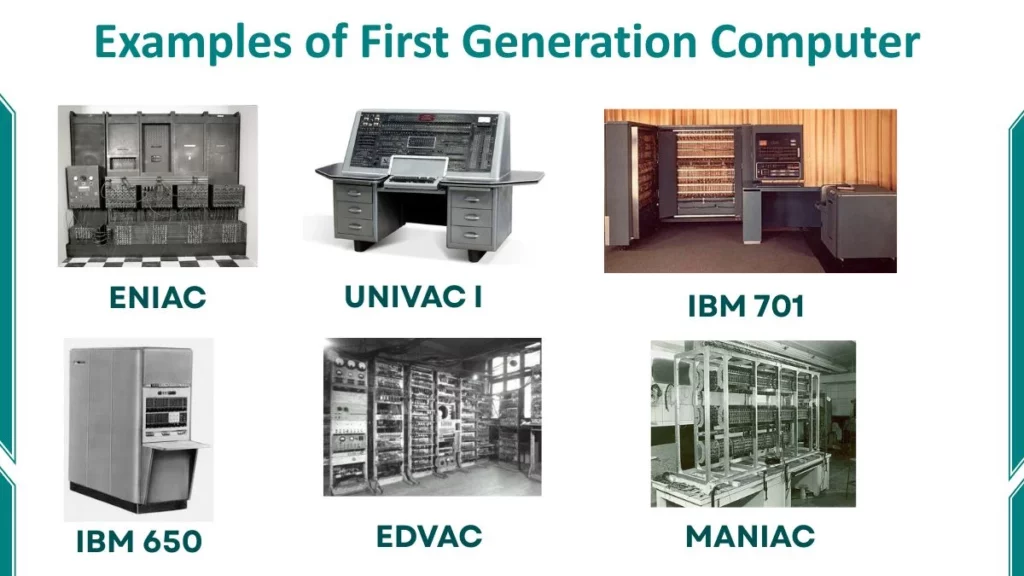Examples of First Generation computers include ENIAC, IBM 701, IBM 650, EDVAC, EDSAC, MANIAC, and many more. We discuss all these examples in detail below.
These are the earliest forms of computers that were built between 1940 and 1956. They use vacuum tubes as the primary electronic component for data processing. To learn about the key benefits and strengths of these early machines, read our detailed guide on the Advantages of First Generation Computers.

Examples of 1st generation computers
The following are list of examples of first generation computer:
- ENIAC
- UNIVAC I
- IBM 701
- IBM 650
- EDVAC
- EDSAC
- LEO I
- MANIAC
- IAS Computer
- Harvard Mark I
Now, let’s discuss each example in detail.
1. ENIAC (Electronic Numerical Integrator and Computer)
ENIAC is the first general-purpose electronic computer built in 1945 by John Mauchly and J. Presper Eckert. It was developed at the University of Pennsylvania for the U.S. Army.
It occupies a whole room and weighs approximately 30 tons. It uses 18,000 vacuum tubes, 70,000 resistors, and 10,000 capacitors.
Features:
- Works on vacuum tube technology.
- Performs 5,000 additions per second.
- Uses punch cards for input and output.
- Requires a large cooling system.
- Consumes 150 kilowatts of electricity.
- Has no internal memory like modern computers.
- Programs are set manually using switches and wires.
Purpose:
ENIAC was designed for military calculations, mainly for artillery firing tables during World War II. Later, it is also used for scientific research and mathematical calculations.
Example:
ENIAC marks the beginning of the electronic computing era. It proves that machines can solve problems faster than humans.
2. UNIVAC I (Universal Automatic Computer I)
UNIVAC I is the first commercial computer developed in 1951 by the same team, Eckert and Mauchly. It is used by businesses and government offices for data processing.
It is much smaller and more practical than ENIAC, designed for real-world data management.
Features:
- Uses vacuum tubes for processing.
- Employs magnetic tape for storage and data input.
- Can handle both numbers and text.
- Faster and more reliable than earlier models.
- Can store up to 1,000 words of data.
- Requires air conditioning due to high heat output.
Purpose:
UNIVAC I is used for commercial and administrative data processing. It handles payroll, inventory management, and statistical analysis.
Example Insight:
UNIVAC I became famous for accurately predicting the 1952 U.S. Presidential Election results.
3. IBM 701
IBM 701 is introduced in 1952 by International Business Machines (IBM). It is IBM’s first scientific computer, designed for defense and scientific research.
It helps solve complex mathematical problems for the U.S. government and research institutions.
Features:
- Uses vacuum tube circuits for logic.
- Operates at a speed of 16,000 additions per second.
- Uses electrostatic storage tubes for memory.
- Supports machine language programming.
- Includes punch card input and printer output.
- Built for continuous operation.
Purpose:
IBM 701 is used for scientific, defense, and research calculations, including atomic energy projects.
Example Insight:
IBM 701 marks IBM’s entry into the computing industry and lays the base for future IBM systems.
4. IBM 650
IBM 650 was launched in 1953. It became the most popular first-generation computer due to its smaller size and cost compared to other systems.
It is used widely by universities, businesses, and engineering firms.
Features:
- Uses vacuum tubes and magnetic drum memory.
- Can store 2,000 words of data.
- Reads and writes data using punch cards.
- Compact design compared to earlier systems.
- Requires less cooling and maintenance.
Purpose:
IBM 650 is used for education, business calculations, and scientific research. It helps students learn programming and computer logic.
Example Insight:
IBM 650 becomes a popular teaching tool and helps train the next generation of computer scientists.
5. EDVAC (Electronic Discrete Variable Automatic Computer)
EDVAC was developed in 1949 by Eckert and Mauchly. It introduces the stored program concept, designed by John von Neumann.
This means both data and instructions are stored in memory. This making it faster and easier to reprogram.
Features:
- Uses vacuum tubes for processing.
- Employs binary numbers (0s and 1s) instead of decimals.
- Includes internal memory for data and instructions.
- Much more efficient than ENIAC.
- Smaller and uses less power.
Purpose:
EDVAC is mainly used for scientific research and program testing. It helps researchers experiment with the concept of stored programs.
Example Insight:
EDVAC becomes the model for modern computer architecture.
6. EDSAC (Electronic Delay Storage Automatic Calculator)
EDSAC was built in 1949 at the University of Cambridge by Maurice Wilkes. It is the first computer to store programs electronically. It helps scientists in performing complex calculations for research and education.
Features:
- Uses mercury delay lines for memory.
- Operates on vacuum tube technology.
- Can store and execute multiple instructions.
- Outputs results on a teleprinter.
- Smaller and more efficient than ENIAC and EDVAC.
Purpose:
EDSAC is used for scientific and academic research. It helps in solving mathematical and logical problems.
Example Insight:
EDSAC introduces the concept of automatic computing and supports early university research.
7. LEO I (Lyons Electronic Office)
LEO-I was built in 1951 by J. Lyons & Co., a British food company. It is based on EDSAC’s design but is used for business purposes. It is the first computer designed for commercial business use.
Features:
- Uses vacuum tubes and magnetic drum storage.
- Handles data processing and record management.
- Performs calculations for payroll, sales, and inventory.
- Operates faster than manual accounting systems.
Purpose:
LEO I is used for business operations, such as managing staff salaries, sales reports, and financial calculations.
Example Insight:
LEO I becomes a pioneer in business computing, showing how computers can improve office work.
8. MANIAC (Mathematical Analyzer, Numerical Integrator, and Computer)
MANIAC was developed in 1952 at the Los Alamos Scientific Laboratory. It is used for nuclear energy and mathematical research. It is based on the IAS computer design.
Features:
- Uses vacuum tubes for logic.
- Supports stored program execution.
- High-speed processing for mathematical problems.
- Performs scientific simulations for atomic research.
Purpose:
MANIAC is used for scientific research, mainly related to nuclear energy and complex simulations.
Example Insight:
MANIAC plays a key role in scientific progress and nuclear studies during the early computer age.
9. IAS Computer (Institute for Advanced Study Computer)
The IAS Computer was developed in 1952 under John von Neumann at the Institute for Advanced Study, Princeton. It becomes the design model for many other computers like MANIAC and ORDVAC.
Features:
- Uses vacuum tube circuits.
- Follows the stored program concept.
- Can store data and instructions together in memory.
- High-speed arithmetic operations.
- Compact compared to ENIAC.
Purpose:
IAS Computer is built for scientific and engineering research. It helps in developing new computing theories and mathematical models.
Example Insight:
IAS Computer becomes the foundation for most modern computer architectures.
10. Harvard Mark I
Harvard Mark I was completed in 1944 by Howard Aiken at Harvard University. It is a large electromechanical computer, combining mechanical switches with electrical parts. It was used during World War II for mathematical and scientific calculations.
Features:
- Works with mechanical relays and switches.
- Uses paper tape for input and output.
- Performs automatic sequences of calculations.
- Slow compared to fully electronic systems.
- Built using over 750,000 components.
Purpose:
Harvard Mark I is used by the U.S. Navy to solve long mathematical tables and military calculations.
Example Insight:
Harvard Mark I is a bridge between mechanical and electronic computers, marking a major step in computing evolution.
To understand how technology advanced after this era, read our detailed article on the Examples of Second Generation Computers.
